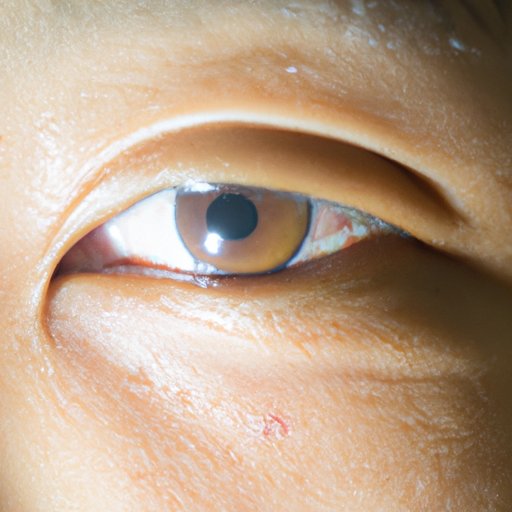
I. Introduction
While tumors behind the eye are not as well-known as other types of eye tumors, they can be dangerous if left undetected and untreated. The purpose of this article is to educate readers on the symptoms associated with a tumor behind the eye, the impact on vision, available diagnosis, and treatment options, and preventative measures.
Recognizing the signs of a tumor behind the eye is crucial as they can be difficult to diagnose, making early detection even more critical. This article aims to provide readers with valuable information about the symptoms and signs to watch out for, and when it is essential to consult a medical professional for help.
II. What are Tumors Behind the Eye?
The eye is a complex organ made up of many parts necessary for vision. The optic nerve, retina, and macula are among the crucial components of the eye, and any tumor formation behind the eye can impact these essential structures.
A tumor behind the eye refers to an abnormal growth that occurs behind the eye within the eye socket or orbit. While tumors can also form within the layers of the eye, those behind the eye can be more complicated since they can grow undetected for an extended period, leading to significant damage to surrounding tissues and organs.
There is no definitive cause for the development of tumors behind the eye. However, it is crucial to note that certain risk factors, including eye injuries, age, exposure to radiation, and a family history of tumors, may increase the likelihood of developing a tumor behind the eye.
III. Symptoms of a Tumor Behind the Eye
One of the main challenges in identifying a tumor behind the eye is that many of its symptoms are common to other eye conditions as well. It is therefore crucial for anyone experiencing unusual or persistent changes in vision or other symptoms to seek medical attention as soon as possible.
Here are several symptoms associated with a tumor behind the eye:
1. Vision-related symptoms
Tumors behind the eye can impact vision in various ways, depending on their size and location. The symptoms can include:
- Blurred vision
- Reduced peripheral vision
- Double vision or ghosting of images
- Flashing or floaters
- Difficulty focusing
- Loss of vision in one or both eyes
2. Pain-related symptoms
Some people with tumors behind the eye may experience pain or discomfort in or around the eye. Pain symptoms can include:
- Bulging or protrusion of the eye
- Eyelid swelling
- Pressure behind the eye
- Pain with eye movement
- Headaches behind the eye
3. Other symptoms
Other symptoms may also be present with a tumor behind the eye. These include:
- Changes in the size or shape of the pupil
- Excessive tearing or dryness of the eye
- Misaligned eyes or lazy eye
- Redness of the eye
- Diplopia or double vision
IV. Diagnosis and Treatment
Diagnosing a tumor behind the eye requires a comprehensive eye exam and imaging tests, such as an MRI or CT scan. If the tests reveal a tumor, your eye care professional will refer you to an oncologist or ophthalmologist who specializes in treating eye tumors.
The treatment options for tumors behind the eye depend on the type of tumor, size, location, and stage. Common treatment options include radiation therapy, surgery, and chemotherapy, or any combination of these treatments. The goal is to minimize the tumor’s impact on vision and prevent the spread of cancerous cells to other parts of the body.
It is essential to understand that treatment for a tumor behind the eye can impact vision, depending on the treatment approach used. After treatment, undergoing regular eye examinations with an eye care specialist is necessary to monitor vision, assess recurrence risks, and ensure early detection if the tumor reappears.
V. Preventative Measures and Future Outlook
It is not always possible to prevent the development of a tumor behind the eye, but certain measures can minimize the risk or delay the onset. These include:
- Protecting the eyes from harmful UV rays by wearing sunglasses and hats
- Managing pre-existing health conditions that increase the risk of eye tumors
- Avoiding exposure to hazardous chemicals and radiation
- Having regular eye exams to detect early signs of eye tumors
Currently, there is ongoing research in both the diagnosis and treatment of tumors. Advancements in technology and medical treatment provide hope for better outcomes for those living with a tumor behind the eye.
VI. Conclusion
Tumors behind the eye are rare, yet can be dangerous if left untreated. Identifying the symptoms and seeking medical attention is crucial in preventing the tumor’s spread and minimizing harm to vision. Eye symptoms should never be ignored, as they can be a sign of a more severe issue, and prompt attention can help prevent further damage.
It is always important to practice preventative measures and undergo regular eye examinations to catch potential problems early during treatment. While it can be overwhelming to receive a diagnosis of an eye tumor, treatment options, and hope for a future impact on vision, it is essential to remember that advancements in science and medical technology offer hope for a bright future for those affected.
When it comes to your eye health, always stay vigilant, seek medical attention early, and understand the importance of routine check-ups.
Lastly, do not wait to get checked if you notice any strange symptoms; time is of the essence when it comes to your vision and overall well-being.





